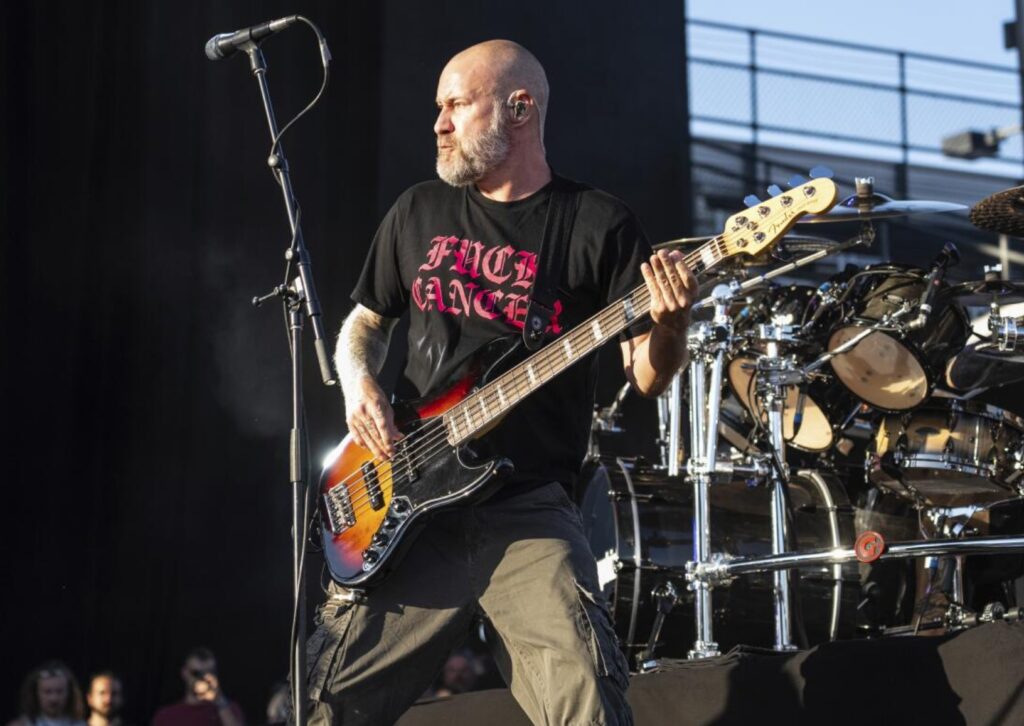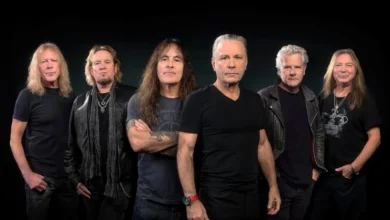Limp Bizkit Bassist Sam Rivers Passes Away at 48

Sam Rivers’ death on October 18, 2025, landed like a shockwave across rock culture. At just 48, the co-founding bassist of Limp Bizkit—the quiet hinge around which their chaos swung—was suddenly gone. The band’s tribute framed him as more than a player: a brother, a pulse, the calm in the storm. For millions who learned to jump in unison to those low-end lines, the news didn’t just mark the end of a life; it marked the end of a specific electricity that only he supplied.
Details were spare in those first hours, and that silence said plenty. The group confirmed his passing but did not disclose a cause, asking for space while the family processed an unthinkable loss. In a time when speculation often drowns out fact, the restraint felt dignified—and very Sam. He was, after all, the band’s most unassuming presence: the architect in the shadows, building foundations so others could climb.
Fans immediately rewound to the final stretch of his career, replaying phone videos from the late-summer run that had carried Limp Bizkit through arenas, sheds, and festivals. The footage is bittersweet now: Rivers at stage left, chin tucked, right hand working that steady down-up economy, turning a sea of strangers into one moving organism. You can see how much of the show’s momentum sat under his fingertips.
Leeds Festival on August 24, 2025, has taken on particular weight. Slotted for a prime hour on the main stage, the band delivered a tight, hit-heavy set that felt like a time capsule cracked open. In hindsight, many are calling it Rivers’ last great festival performance: a field shaking under an evening sky while his bass stitched the mayhem together. Without a eulogy in sight, the music did the talking.
What makes his absence feel so heavy is how specifically he shaped the band’s language. Limp Bizkit’s signature bounce—the way riffs snap, drop, and spring back—depends on a bassist who can be both metronome and trampoline. Rivers excelled at that paradox. He gave the drums a shoulder to lean on and the guitars a floor to slam against. Remove that, and the physics of the songs change.
His path to those physics wasn’t linear. In 2015, Rivers stepped away from touring as severe liver disease forced him into a fight that would define the next few years. It was grueling and public in all the ways musicians dread, but he made it through, receiving a transplant in 2017. When he returned in 2018, he carried the focus of someone who had learned exactly how precious a loud stage could be.
That comeback sharpened the band. The veteran version of Limp Bizkit still loved spectacle and humor, but beneath the antics was a steadier machine. Rivers played like a craftsman with no bandwidth for waste: clean entries, decisive mutes, and those satisfying slides into choruses that make crowds move before they think. Late-era shows had fewer rough edges not because the group got cautious, but because the engine room got wiser.
It’s tempting to define him only by the big radio staples, yet Rivers’ imprint runs deeper than the obvious hits. Listen to the connective tissue between choruses, the pre-breakdown bars where nothing dramatic happens—and feel how the groove never sags. That’s where his musicianship lived. He treated space like an instrument, leaving just enough air for the crowd to fill with noise.
His death also reframes the band’s 2025 arc. Those summer dates—Middle East heat, European festivals, a swing through Turkey—now read like a final lap completed at full tilt. Clips from that month show a group comfortable in its skin, leaning into the theater without irony. Rivers, all black and no fuss, remains the unflashy counterpoint that made the picture work: one player holding the kite string while everyone else flew.
The tributes from peers have converged on the same idea: Sam Rivers played for the song. In an era of surgical virtuosity, he chose clarity and feel. That choice earned him a different kind of respect—the respect you get when singers feel taller, drummers feel braver, and guitarists feel wilder because you’re there. Bandmates can’t fake that gratitude. You can hear it in how they talk about him now.
For fans, the grief is strangely physical. Rivers’ parts weren’t just heard; they were worn. People remember the first time their chest rattled at a festival barricade, the way a sub-bass thump matched their heartbeat, the instant recognition of a tone that said, unequivocally, “jump.” A death like this removes a sound from the world, and those who lived inside that sound notice immediately.
Industry observers often credit the frontman’s charisma or the guitarist’s costumes for the band’s longevity. Fair enough. But the reason Limp Bizkit keeps detonating fields three decades on is because the rhythm section never forgot its job. Rivers’ bass lines were blueprints for kinetic architecture: simple enough to memorize, sturdy enough to hold thirty thousand people at once. That’s engineering disguised as attitude.
As the condolences rolled in, a secondary conversation bloomed around health, recovery, and the quiet costs of touring life. Rivers’ earlier battle, his transplant, and his return gave many musicians permission to talk about their own limits. His legacy, then, is also pastoral: a reminder that survival is a creative act, and that coming back can be as artistically significant as breaking through.
There’s a patchwork of images people are holding on to now. Backstage smiles that look like exhale. A pre-show huddle where he leans in, eyes soft but focused. The neutral stance at stage left, knees flexed to absorb the first kick-drum thump. None of them are dramatic, and that might be why they sting. They show the person doing the work that made the fireworks possible.
In the weeks ahead, practical questions will surface—memorials, tributes, and how the band charts a path that honors him without trying to replace what cannot be replaced. Those decisions are for the family and the group. For the rest of us, the directive is simpler: carry the groove forward. Play the lines. Share the tapes. Tell the stories that only you can tell from the place where you stood.
If you revisit the late-August shows now, you’ll notice small moments you missed. A glance across the riser that lands with a nod. The way the low end blooms just before a chorus hits. The extra half-second he holds a note so the kick can chase it. These are tiny gifts from a meticulous player, still revealing themselves on the tenth watch.
There’s an argument that nu-metal’s durability lives in muscle memory: riffs engineered for bodies, not just ears. By that logic, Rivers was one of the genre’s master designers. He wrote parts that made strangers behave like a single instrument. Even people who rolled their eyes at the aesthetics felt the tug when his lines arrived. That’s cultural glue hiding in plain sight.
Leeds 2025 will keep drawing attention because it carries the shape of a goodbye, even if unintended. The light is warm, the air is dusted with late-summer haze, and the crowd sounds like weather. When the phones go up during a chorus and drop in unison for the pit, you can almost map the invisible current he’s sending through the field. It’s proof you can conduct a storm without ever stepping to the front.
In private, band grief often looks like work—logistics, calls, the numbing chores no one sees. In public, it looks like gratitude. You’ll hear it in how they talk about the next set of stages, and in the setlists that choose communion over novelty. Rivers would likely prefer it that way: less speech, more music, let the low end do the talking.
The history books will slot his name next to sales figures and tour milestones. Fair, but incomplete. The fuller accounting is in the unrecorded seconds—the eye contact with a security guard when the barricade gets rowdy, the little wave to a kid on a parent’s shoulders, the breath he takes before the downbeat that tells the drummer, “I’m here.” Those are the artifacts that don’t chart yet define a band.
There’s comfort in one certainty: the bass lines remain. They will continue to roll out of worn car speakers and massive festival PAs alike, stitching together new rooms of strangers. Each time they do, they carry a signature that only Sam Rivers could write—clean, heavy, human. The man is gone. The motion he set in place isn’t.
And so the story shifts from shock to stewardship. Fans will keep the clips alive, players will learn the parts, and the band—however it chooses to proceed—will play with a missing heartbeat that the audience will willingly supply. It’s what happens when a musician’s work becomes a communal reflex. You don’t forget; you take your place in the pattern he designed.
If the measure of a life in music is the size of the silence it leaves, Sam Rivers’ is enormous. But within that quiet is a rhythm still felt by anyone who ever shouted a chorus over his lines. Listen closely and you can hear it: the count-in he gave before every detonation, the promise embedded in a perfectly placed note. One, two, three, four—go.
Sources: Band death announcement and obituaries confirming Oct 18, 2025 and age 48; cause of death not disclosed; Rivers’ 2015 health hiatus and 2017 liver transplant; return in 2018; Leeds Festival Aug 24, 2025 main-stage set time.





